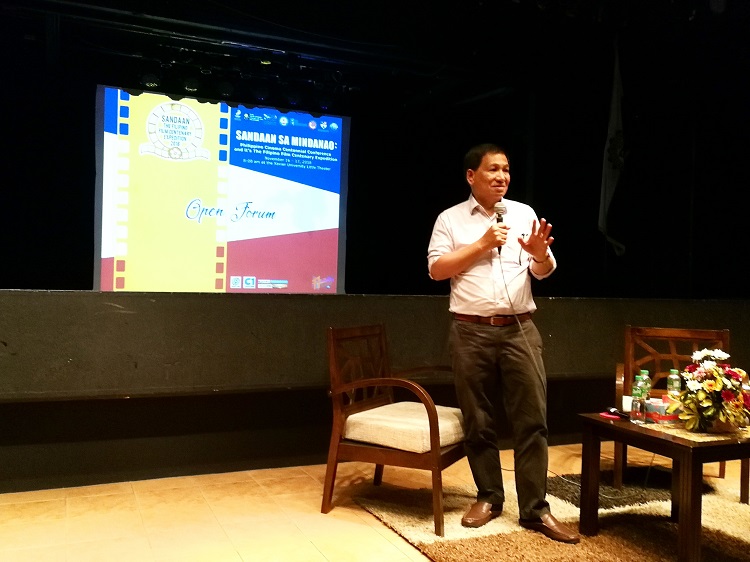
CRITIQUING DIVERSE FILMS. Renowned film critic Tito Valiente encourages viewers to watch a diverse set of films to gain new perspectives. He is one of the speakers during the two-day conference.
Text and photos by Angelo Lorenzo
Xavier University - Ateneo de Cagayan witnessed the 100th celebration of Philippine cinema through the "Sandaan sa Mindanao: The Philippine Cinema Centennial Conference and the Filipino Film Centenary Expedition" on November 16 and 17 at the XU Little Theater.
Organized by the Xavier Center for Culture and the Arts (XCCA), the two-day celebration involved guest speakers who are experts in filmmaking, film criticism, and film studies — all of which had perpetuated the legacy of Filipino cinema since it formally established the industry a century before.
The National Commission for Culture and the Arts (NCCA), through the National Committee on Cinema, and the Film Development Council of the Philippines (FDCP), planned to hold the celebration in — the three major island groups of the Philippines (Luzon, Visayas, and Mindanao). Slated to conclude in 2019, the three-year celebration paid tribute to the conception of Philippine cinema through Don Jose Nepomuceno’s Malayan Films production company in 1917 and the eventual first Filipino film in 1919, “Dalagang Bukid (Maiden of the Province).”
This year, Xavier Ateneo provided a venue for the Mindanao expedition with the support of ABS-CBN and Cinema One. Tackling films at its core, the conference highlighted the importance of regional filmmaking for the industry.
Local narratives
The two-day celebration streamed films that presented narratives in different places of the Philippines, from the tribal conflicts in the south in the 1937 classic, “Zamboanga” (later on named as “Fury in Paradise”) directed by Eduardo de Castro, to the economic struggles in Manila in Lino Brocka’s 1975 drama “Maynila sa Mga Kuko ng Liwanag (Manila in the Claws of Light),” to the comedic interracial engagement in Maria Victoria Beltran and Remton Siega Zuasola’s finalist to the 2010 Cinema One Originals “Ang Damgo ni Eleuteria” (Eleuteria’s Dream). All these films had been critically acclaimed during their time of release.
But behind the scenes, speakers emphasized the value of filmmaking, especially with their impact in the regions.
“Filmmakers are open to collaborating with local storytellers to promote narratives of the regions,” said Cebu-based filmmaker Ara Chawdhury.
Underscoring vibrant regional filmmaking, Chawdhury, who also played one of the characters in “Ang Damgo ni Eleuteria” and has directed and supported films in the Visayan language in the ongoing span of her career, led the discussion about the resurgence of Cebuano cinema.
She shared that some of the earliest films in the country were made by Cebuano filmmakers for the audience in the region before the film industry in Manila became a trend in the second half of the 20th century.
Today, regional filmmaking reels back to the silver screen, with 2016’s Pista ng Pelikulang Pilipino entry, “Patay na Si Hesus” (directed by Victor Villanueva) earning lucrative revenue and trending on social media during its initial release.
Cinematic achievements for regional filmmaking could not have been made possible without efforts and initiatives to promote them. This is one of the many pursuits by the XCCA as shared by director Hobart Savior who presented filmmaker Dax Cañedo’s “Guerilla’s in the Midst: A Narrative on the Role of Mindanao Cinema in the Digital Age.”
This lecture shared about filmmaking workshops and pieces of training, as well as film festivals where films made by regional filmmakers have been given a platform to share local narratives. Such initiatives have already been pursued by local government units in Mindanao, particularly in Davao and General Santos City.
In Northern Mindanao, where Cagayan de Oro takes centerstage, XCCA’s Cinemagis, the film festival for digital short films, has reached a decade this year. With the same age and vision as Cinema Rehiyon, Cinemagis aims to provide an avenue where filmmakers in Northern Mindanao can share their vision integrated with the region's’ culture and context.
“Film organizations and companies like the FDCP and many others are willing to promote local filmmaking to the regions,” said Savior.
As the Philippine cinema has reached a century, films may also represent the diversity of the country. According to film critic and head of the film journalism group of NCCA’s Executive Committee for Cinema, films need to relay certain messages to speak to their viewers.

PROMOTING LOCAL FILMS. Xavier University’s VP for mission and ministry Irene Guitarte (leftmost) acknowledges the common message that XCCA director Hobart Savior (center) and filmmaker Ara Chawdhury (rightmost) relayed in their lectures: the value local narratives through the film.
Films are political
“All films are political,” Valiente said. With his experience in critiquing a variety of films, he said that one major aspect that critics want to find out is the vision of the filmmaker, which can be elaborated with the narrative, the cinematography, the style, and the duration.
Valiente discussed films’ impact on their viewers. His lecture, “Loving Cinema but not Living It: Reading and Teaching Reality and Artifice” encouraged the audience during the conference, composed mostly of students and the academe from schools all over Northern Mindanao, to be critical about the films they are watching and to not just watch for the sake of passive entertainment but also for education.
“I encourage you to watch diverse films to gain different perspectives,” Valiente said.
For University of the Philippines Film Institute director Patrick Campos, the messages of films resonate with the relevant issues in their time of release.
In his “Philippine Cinema, A Century Hence” lecture, Campos detailed how films in the Philippines have evolved over the years, from the American-made during the early years of the Commonwealth era to Western-inspired narratives in the 1950s and the 1960s, the politically-driven box office hits in the 1970s and 1980s, and the contemporary flicks from the late 1990s to the present era.
“All films yield some sort of historical and cultural origin,” he said. “To understand a certain culture, it is important to know and analyze the most famous film in a certain place. Culture is an important factor in producing films.”
As an example, he showed a clip of the late action star and National Artist Fernando Poe Jr’s 1986 action film, “Magnum Muslim .357” which became popular in Mindanao when it first hit the cinemas nationwide.
“Aside from culture, factors such as politics, the economy, and the government should also be considered when producing a film for the Filipino audience,” Campos shared.
Continuing the legacy
As Philippine cinema has made an impact on Filipino viewers in every generation since it began a century ago, organizations like NCCA, FDCP, and XCCA seek to continue this legacy. The regional filmmaking industry is being sought to produce films that magnify the unique narratives in the country’s diverse regions.
This is one of the many reasons why the TPCCC-FFCE will take place in major cities across the Philippines to promote filmmaking as a cultural and educational endeavor that sheds light over the issues and concerns of every Filipino.
TPCCC-FFCE took place in Luzon, specifically at De La Salle University - Dasmariñas, Cavite from November 22 to 23. The Visayas also provided venue for the conference at the University of the Philippines Visayas (Iloilo City), West Visayas State University (Iloilo City), Filamer Christian University (Roxas City, Capiz), the Department of Education - Schools Division of Capiz, and at the Negros Museum (Bacolod City) in the same month.∎

FILM APPRECIATION. During the two-day conference, students, teachers, and the academe from different schools in Northern Mindanao flock the XU Little Theater to listen to the lectures, join the discussions, and screen films.